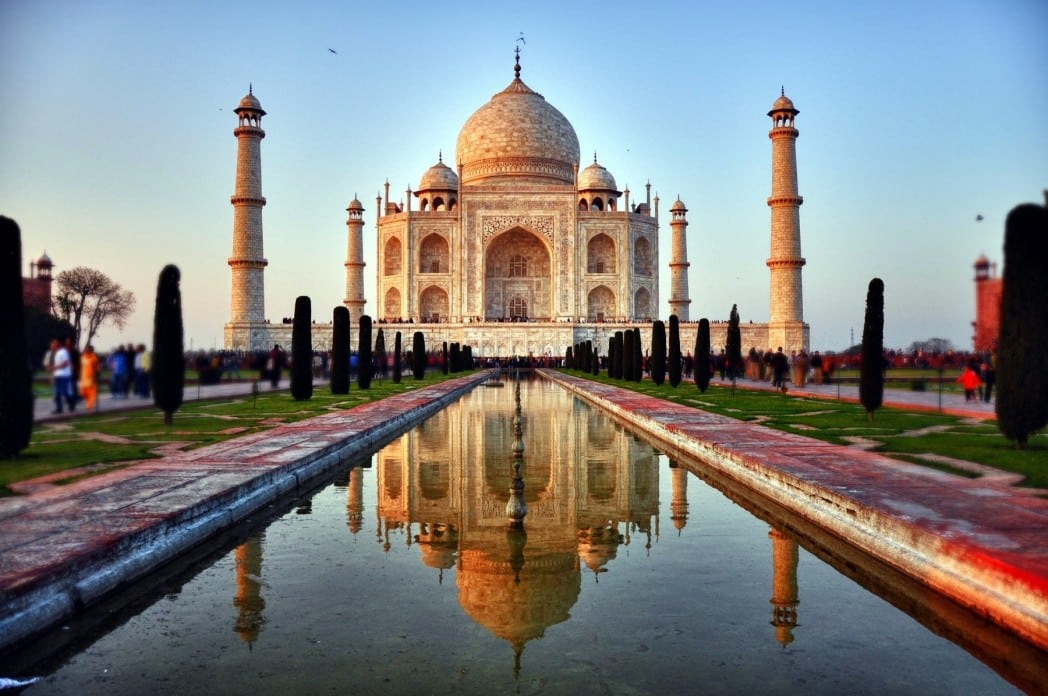Taj Mahal India
The Taj Mahal is a beautiful white marble mausoleum in the city of Agra, India. It is widely considered to be one of the greatest architectural masterpieces in the world and is listed as one of the New Seven Wonders of the World. Every year, the Taj Mahal receives visits from between four and six million tourists from all over the world.
Probably for Taj Mahal, the axiom is just the other way round.The Taj is the beauty personified! The Taj displays its different moods through its varied shades. The Taj has as many shades as any kind of beauty can ever have!
Interestingly, less than 500,000 of those visitors are from overseas; the vast majority are from India itself. UNESCO has designated the building and its grounds as an official World Heritage Site, and there is much concern that the sheer volume of foot traffic may have a negative impact on this wonder of the world. Still, it is hard to blame people in India for wanting to see the Taj, since the growing middle class there finally has the time and leisure to visit their country's great treasure.

Why the Taj Mahal Was Built
The Taj Mahal was built by the Mughal Emperor Shah Jahan (r. 1628 - 1658) in honor of the Persian princess Mumtaz Mahal, his beloved third wife. She died in 1632 while bearing their fourteenth child, and Shah Jahan never really recovered from the loss. He poured his energy into designing and building the most beautiful tomb ever known for her, on the southern banks of the Yamuna River.
It took some 20,000 artisans more than a decade to build the Taj Mahal complex. The white marble stone is inlaid with floral details carved from precious gems. In places, the stone is carved into delicate vined screens called pierce work so that visitors can see into the next chamber. All of the floors are inlaid with patterned stone, and incised painting in abstract designs adorns the walls. The artisans who did this incredible work were supervised by an entire committee of architects, headed by Ustad Ahmad Lahauri. Uk visa requirements. The cost in modern values was about 53 billion rupees ($827 million US). Construction of the mausoleum was completed around 1648.
The Taj Mahal Today
The Taj Mahal is one of the loveliest buildings in the world, combining architectural elements from across the Muslim lands. Among the other works that inspired its design are the Gur-e Amir, or the Tomb of Timur, in Samarkand, Uzbekistan; Humayun's Tomb in Delhi; and the Tomb of Itmad-Ud-Daulah in Agra. However, the Taj outshines all of these earlier mausoleums in its beauty and grace. Its name literally translates as 'Crown of Palaces.'
Shah Jahan was a member of the Mughal Dynasty, descended from Timur (Tamerlane) and from Genghis Khan. His family ruled India from 1526 to 1857. Unfortunately for Shah Jahan, and for India, the loss of Mumtaz Mahal and the construction of her amazing tomb utterly distracted Shah Jahan from the business of governing India. He ended up being deposed and imprisoned by his own third son, the ruthless and intolerant Emperor Aurangzeb. Shah Jahan ended his days under house arrest, lying in bed, gazing out at the white dome of the Taj Mahal. His body was interred in the glorious building he had made, beside that of his beloved Mumtaz.
The ticket price for Indian visitors to the Taj Mahal has been raised by 400%, in the latest attempt to lower tourist numbers and reduce damage to the country’s top tourist site.
Indians make up the majority of the Taj Mahal’s 10,000-15,000 average daily visitors. Nearly 6.5 million people marvelled at the white marble 17th-century masterpiece in 2016.
An all-inclusive ticket for Indian citizens into the Unesco world heritage complex, which includes entry into the Taj Mahal built by Mughal emperor Shah Jahan as a tomb for his beloved wife Mumtaz Mahal, was raised from 50 rupees (55p) to 250 rupees. The price rise came into effect on Monday.
International tourists will pay roughly $19 to enter the site in northern India, up from $16.
:max_bytes(150000):strip_icc()/GettyImages-AB13214-56adde223df78cf772b81d33.jpg)
Taj Mahal India Blogs
“We want people to pay more to limit the footfall,” a spokesperson from the Archaeological Survey of India, the government body responsible for upkeep, told AFP. “This will cut down the number of visitors to the mausoleum by at least 15-20% and generate revenue for its conservation,” the spokesperson said.
The latest move comes only months after Indian authorities restricted the number of tourists to 40,000 per day. Previously, up to 70,000 people would visit the site at weekends.

Experts say the huge flow of people is causing irreversible damage to the marble floor, walls and foundations.
Officials have also struggled to stop the white marble from turning yellow as pollution levels rise in the northern city of Agra.
Taj Mahal Indian Restaurant
Taj Mahal gets a facelift – and slaps on a mudpack
Further damage is being caused by excrement by insects from the noxious adjacent Yamuna river, one of India’s most polluted waterways.
In July, India’s supreme court threatened to either shut or tear down the monument over the failure of the authorities to protect it from degradation.
The court asked the Indian authorities to consult international experts to speed up the conservation efforts.